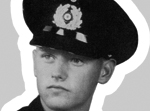| |
 |
|
|
|
| |
 |
Midshipman
Jörn Jaap
* 20.11.1920 in Berlin - † 27.5.1941
|
 |
|
|


Germany (1920)
Source:
Crewbook Crew X/39
|
Jörn Jaap was born on November 20, 1920 in Berlin. After graduating from high school, he decided to join the Navy as an officer candidate. In mid-September 1939, he was called up to the 7th Schiffsstammabteilung in Stralsund, where basic training began. Two and a half months later, he was assigned to one of the training ships. After almost half a year on board, he then attended the midshipman course at the Mürwik Naval School. In school classes, Jörn Jaap learned the theoretical basics of officer's craft, such as navigation and tactics, and also how to behave as a superior, in the company of his crew mates. The knowledge he had learned was tested in a main exam towards the end of the course. Jörn Jaap passed the exam and was promoted to Midshipman He then went to a land command within the troops, where he was to apply the knowledge he had acquired so far in practice and gain new experience. A specialist course followed before the young midshipman was assigned to the battleship Bismarck on February 1, 1941. He wrote about an experience from his time on board for the crew magazine: "One beautiful afternoon, we were lying somewhere on the pier when our comfortable peace and quiet was suddenly disturbed. There was a rumor that 180 anti-aircraft ensigns wanted to inspect our beautiful ship. We, as naval and engineering midhsipmen, were chosen to lead the tour. The number 180 seemed exaggerated to us, but in the end we were satisfied with it, especially since we were used to calculating with abnormal numbers on our ship.
|
|
|
1 Jörn Jaap alludes to the observation of impact during artillery firing.
2 Jörn Jaap allowed himself a few jokes with his comrades in the Luftwaffe.
|
They came. A seemingly endless procession of curious people rolled up the gangway and formed 'unorganized' groups on deck. We asked our comrades to form up for better organization, which they agreed to and took up military formation. Each of us was given 10 ensigns. Right from the start we had to endure a multitude of questions. Most of the questions were questionable and some could no longer be observed.1 We were presented with the spectacle of a thirst and urge for knowledge making one's own knowledge seem insignificant. In the 38 cm turret, which made a big impression, the question was raised whether a 38 also had a recoil. Of course we answered this question in the negative, since it is well known that the caliber is inversely proportional to the recoil, i.e. the larger the caliber, the smaller the recoil.2
After we had climbed the 'stairs' through the various 'floors' to the forward artillery direction center, the thickness of the armor was naturally admired. Some who did not believe in the strength of the armor knocked on it with their knuckles and were surprised that nothing could be heard from the stand. Now even the last person was convinced.
|
|
|
3 OKM = High Command of the Navy
|
We continued up. Some grumbled and the question arose as to why there was no elevator on such a modern ship. We were very enthusiastic about this suggestion and wanted to propose it personally to OKM3. From there we went into the engine rooms at a lower rate of descent. The contrast was too great. One of them asked whether we were already at the bottom, as we could already see the sea water. The engineer midshipmen then explained with a forgiving smile that it was so-called bilge water. The question itself is not so unjustified, as we know that our modern ships have no bottom, but only air pressure prevents water from entering the hull.
|
|
|
4 B.d.W. = Petty officer of the Watch
|
The time was up. The ensigns went to guard duty. As an encore, so to speak, they experienced a review of an midshipman as B.d.W..4 Their eyes widened in shock as expressions such as 'lousy', 'shabby', 'get out of here!' reached them in a loud tone and one soldier after another had to leave the field. The runner on deck, who was cleaning the guard area with a Piassava broom in the performance of his duties, enveloped our guests in a large cloud of dust so that they could only make themselves known acoustically. The farewell came, and from the lips of many an Luftwaffe ensign came the sigh: 'Thank God I'm not in the navy.' This sigh made our chests swell with pride."
Four months after his command, Jörn Jaap set sail on the Bismarck. He did not survive the sinking of the ship and died on May 27, 1941 at the age of 20.
|
|
|